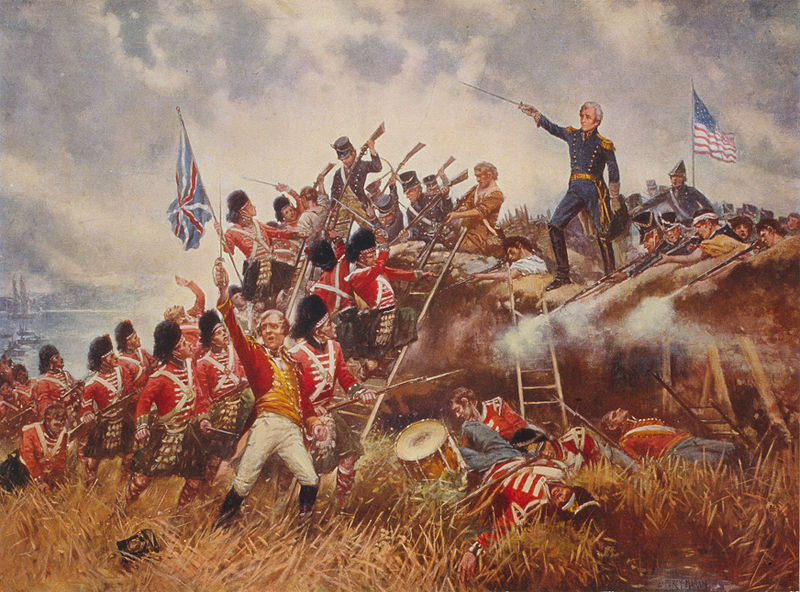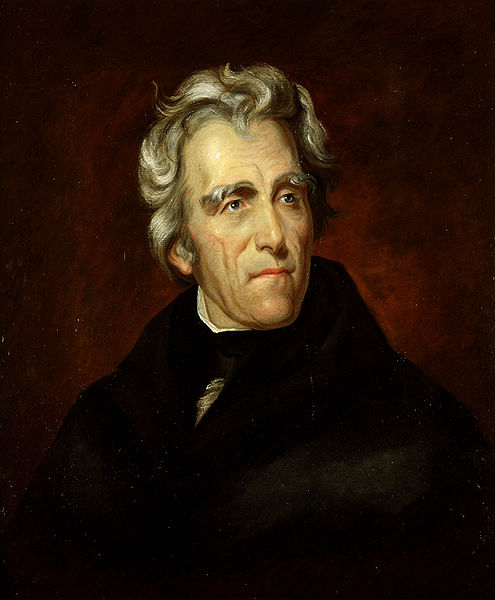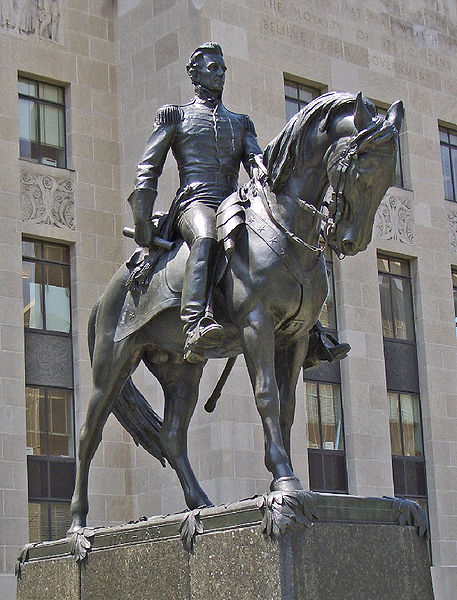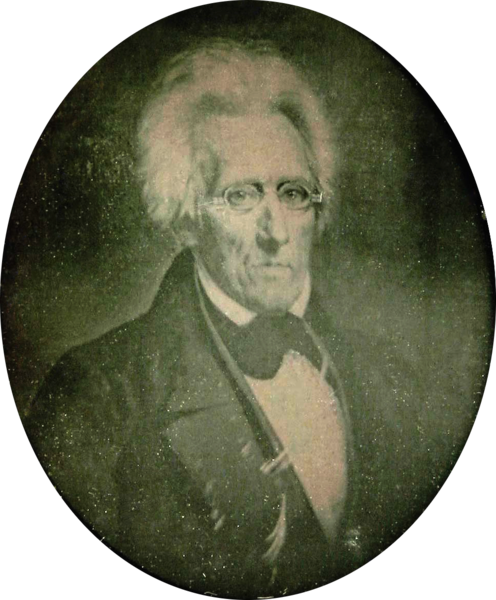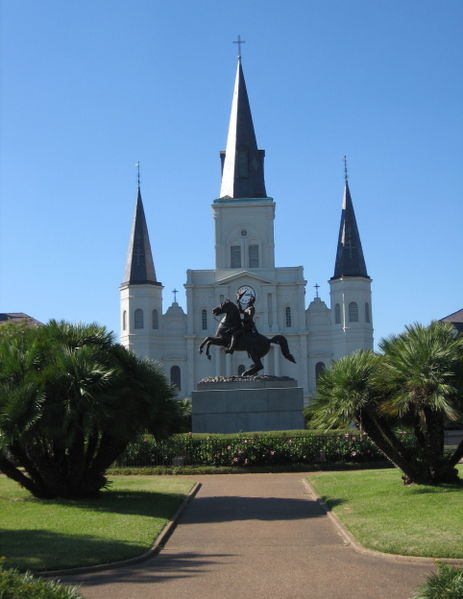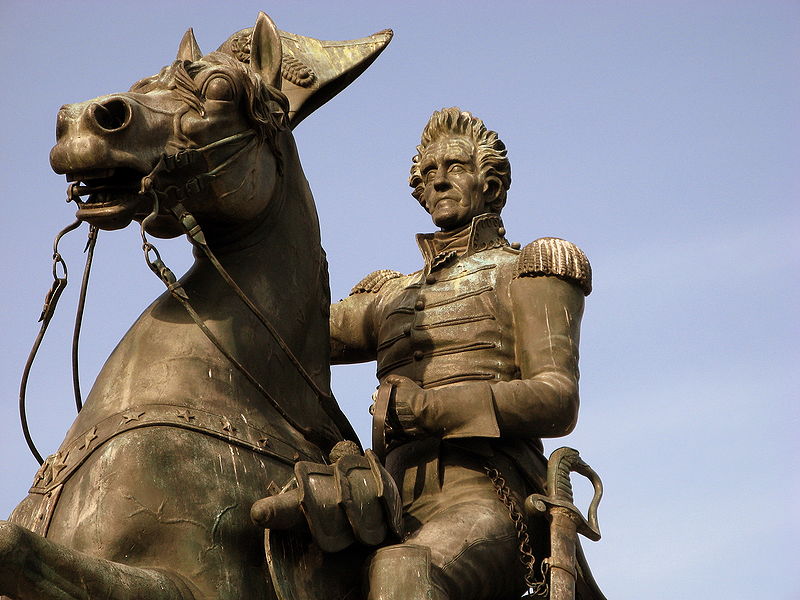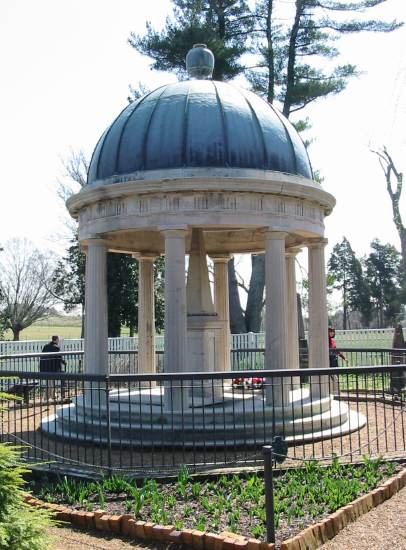<Back to Index>
- Mathematician Heinrich Eduard Heine, 1821
- Writer Paul Johann Ludwig von Heyse, 1830
- 7th President of the United States Andrew Jackson, 1767
PAGE SPONSOR
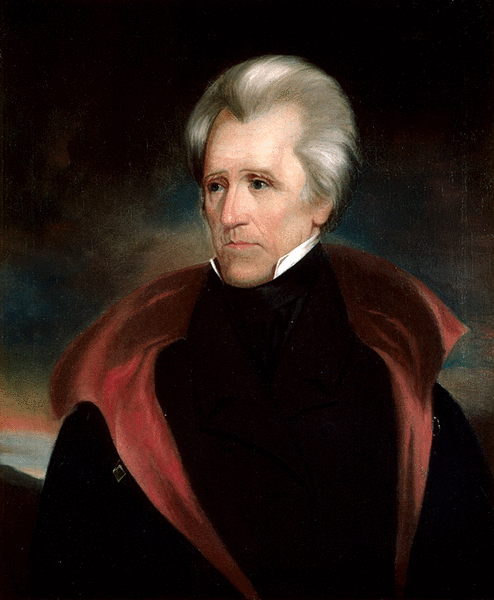
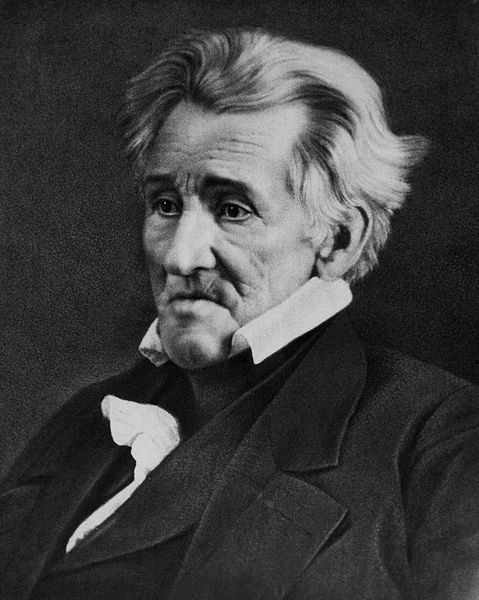
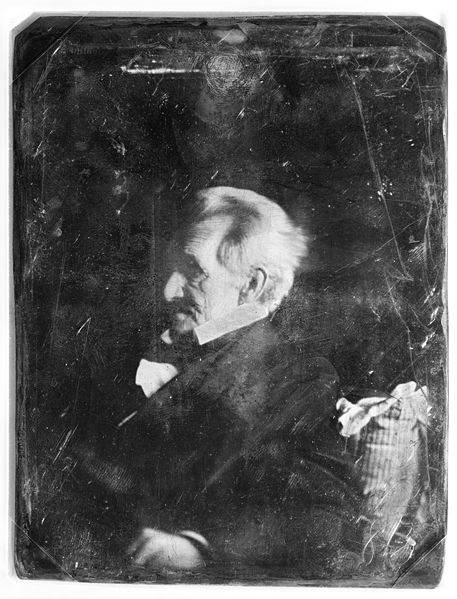
Andrew Jackson (March 15, 1767 – June 8, 1845) was the seventh President of the United States (1829 – 1837). He was the military governor of pre-admission Florida (1821) and the commander of the American forces at the Battle of New Orleans (1815) and is an eponym of the era of Jacksonian democracy. A polarizing figure who dominated the Second Party System in the 1820s and 1830s, his political ambition and widening political participation shaped the modern Democratic Party.
His
legacy is now seen as mixed, as a protector of popular democracy and
individual liberty for American citizens, checkered by his support for slavery and Indian removal. Renowned for his toughness, he was nicknamed "Old Hickory". As he based his career in developing Tennessee, Jackson was the first president primarily associated with the American frontier. Jackson was born to Presbyterian Scotch - Irish colonists Andrew and Elizabeth Hutchinson Jackson, on March 15, 1767, two years after they had emigrated from Ireland. Jackson's father was born in Carrickfergus, County Antrim, in Ireland around 1738. He married Elizabeth, sold his land and emigrated to America in 1765. The
Jacksons probably landed in Pennsylvania and made their way overland to
the Scotch - Irish community in the Waxhaws region, straddling the border between North and South Carolina. Jackson
had two brothers, Hugh (born 1763) and Robert (born 1764). Jackson's
father died in an accident in February 1767, at the age of 29, three
weeks before Jackson was born. The house that Jackson's parents lived
in is now preserved as the Andrew Jackson Centre and
is open to the public. Jackson was born in the Waxhaws area, but his
exact birth site was the subject of conflicting lore in the area. He
claimed to have been born in a cabin just inside South Carolina.
Controversies about Jackson's birthplace went far beyond the dispute
between North and South Carolina. Because of his heroic stature and
humble origins, there was much speculation. Jackson received a sporadic education in the local "old-field" school. During the American Revolutionary War, Jackson, at age thirteen, joined a local militia as a courier. His eldest brother, Hugh, died from heat exhaustion during the Battle of Stono Ferry,
on June 20, 1779. Jackson and his brother Robert were captured by the
British and held as prisoners; they nearly starved to death in
captivity. When Jackson refused to clean the boots of a British
officer, he slashed at the youth with a sword, giving him scars on his
left hand and head, as well as an intense hatred for the British. While
imprisoned, the brothers contracted smallpox. Robert died a few days
after their mother secured their release, on April 27, 1781. After his
mother was assured Andrew would recover, she volunteered to nurse
prisoners of war on board two ships in Charleston harbor, where there
had been an outbreak of cholera. She died from the disease in November
1781, and was buried in an unmarked grave, leaving Jackson an orphan at
age 14. Jackson's entire immediate family had died from hardships during the war; Jackson blamed the British. Jackson was the last U.S. President to have been a veteran of the American Revolution. In 1781, Jackson worked for a time in a saddle-maker's shop. Later, he taught school and studied law in Salisbury, North Carolina. In 1787, he was admitted to the bar, and moved to Jonesborough, in what was then the Western District of North Carolina. This area later became the Southwest Territory (1790), the precursor to the state of Tennessee. Though his legal education was scanty, Jackson knew enough to be a country lawyer on the frontier.
Since he was not from a distinguished family, he had to make his career
by his own merits; soon he began to prosper in the rough-and-tumble
world of frontier law. Most of the actions grew out of disputed
land claims, or from assault and battery. In 1788, he was appointed Solicitor of the Western District and held the same position in the government of the Territory South of the River Ohio after 1791. In 1796, Jackson was a delegate to the Tennessee constitutional convention. When Tennessee achieved statehood that year, Jackson was elected its U.S. Representative. In 1797, he was elected U.S. Senator as a Democratic-Republican. He resigned within a year. In 1798, he was appointed a judge of the Tennessee Supreme Court, serving until 1804. Besides
his legal and political career, Jackson prospered as a slave owner,
planter, and merchant. In 1803 he owned a lot, and built a home and the
first general store in Gallatin, Tennessee. In 1804, he acquired the Hermitage, a 640-acre (2.6 km2) plantation in Davidson County, near Nashville, Tennessee. Jackson later added 360 acres (1.5 km2) to the farm. The plantation eventually grew to 1,050 acres (425 ha). The primary crop was cotton,
grown by enslaved workers. Jackson started with nine slaves, by 1820 he
held as many as 44, and later held up to 150 slaves. Throughout his
lifetime Jackson may have owned as many as 300 slaves. Jackson was a major land speculator in West Tennessee after he had negotiated the sale of the land from the Chickasaw Nation in 1818 (termed the Jackson Purchase) and was one of the three original investors who founded Memphis, Tennessee, in 1819. Jackson was appointed commander of the Tennessee militia in 1801, with the rank of colonel. During the War of 1812, Tecumseh incited the "Red Stick" Creek Indians of northern Alabama and Georgia to attack white settlements. Four hundred settlers were killed in the Fort Mims Massacre. In the resulting Creek War, Jackson commanded the American forces, which included Tennessee militia, U.S.regulars, and Cherokee, Choctaw, and Southern Creek Indians. Jackson defeated the Red Stick Creeks at the Battle of Horseshoe Bend in 1814. Eight hundred "Red Sticks" were killed, but Jackson spared chief William Weatherford. Sam Houston and David Crockett served under Jackson in this campaign. After the victory, Jackson imposed the Treaty of Fort Jackson upon
both the Northern Creek enemies and the Southern Creek allies, wresting
twenty million acres (81,000 km²) from all Creeks for white
settlement. Jackson was appointed Major General after this action. Jackson's
service in the War of 1812 against the United Kingdom was conspicuous
for bravery and success. When British forces threatened New Orleans,
Jackson took command of the defenses, including militia from several
western states and territories. He was a strict officer but was popular
with his troops. It was said he was "tough as old hickory" wood on the
battlefield, which gave him his nickname. In the Battle of New Orleans on
January 8, 1815, Jackson's 5,000 soldiers won a victory over 7,500
British. At the end of the day, the British had 2,037 casualties: 291
dead (including three senior generals), 1,262 wounded, and 484 captured
or missing. The Americans had 71 casualties: 13 dead, 39 wounded, and
19 missing. The war, and especially this victory, made Jackson a national hero. He received the Thanks of Congress and a gold medal by resolution of February 27, 1815. Alexis de Tocqueville later commented in Democracy in America that
Jackson "...was raised to the Presidency, and has been maintained
there, solely by the recollection of a victory which he gained, twenty
years ago, under the walls of New Orleans."
Jackson served in the military again during the First Seminole War. He was ordered by President James Monroe in December 1817 to lead a campaign in Georgia against the Seminole and Creek Indians. Jackson was also charged with preventing Spanish Florida from
becoming a refuge for runaway slaves. Critics later alleged that
Jackson exceeded orders in his Florida actions. His directions were to
"terminate the conflict." Jackson
believed the best way to do this was to seize Florida. Before going,
Jackson wrote to Monroe, "Let it be signified to me through any
channel... that the possession of the Floridas would be desirable to
the United States, and in sixty days it will be accomplished." Monroe gave Jackson orders that were purposely ambiguous, sufficient for international denials. The
Seminoles attacked Jackson's Tennessee volunteers. The Seminoles'
attack, however, left their villages vulnerable, and Jackson burned
them and the crops. He found letters that indicated that the Spanish
and British were secretly assisting the Indians. Jackson believed that
the United States could not be secure as long as Spain and the United
Kingdom encouraged Indians to fight, and argued that his actions were
undertaken in self-defense. Jackson captured Pensacola, Florida,
with little more than some warning shots, and deposed the Spanish
governor. He captured and then tried and executed two British subjects, Robert Ambrister and Alexander Arbuthnot,
who had been supplying and advising the Indians. Jackson's action also
struck fear into the Seminole tribes as word spread of his ruthlessness
in battle (Jackson was known as "Sharp Knife"). The
executions, and Jackson's invasion of territory belonging to Spain, a
country with which the U.S. was not at war, created an international
incident. Many in the Monroe administration called for Jackson to be censured. Jackson's actions were defended by Secretary of State John Quincy Adams, an early believer in Manifest Destiny.
When the Spanish minister demanded a "suitable punishment" for Jackson,
Adams wrote back, "Spain must immediately [decide] either to place a
force in Florida adequate at once to the protection of her territory
... or cede to the United States a province, of which she retains
nothing but the nominal possession, but which is, in fact ... a post of
annoyance to them." Adams used Jackson's conquest, and Spain's own weakness, to get Spain to cede Florida to the United States by the Adams - Onís Treaty. Jackson was subsequently named military governor and served from March 10, 1821, to December 31, 1821.
The Tennessee legislature nominated Jackson for President in 1822. It also elected him U.S. Senator again.
By 1824, the Democratic-Republican Party had become the only functioning
national party. Its Presidential candidates had been chosen by an
informal Congressional nominating caucus,
but this had become unpopular. In 1824, most of the
Democratic - Republicans in Congress boycotted the caucus. Those who
attended backed Treasury Secretary William H. Crawford for President and Albert Gallatin for Vice President. A Pennsylvanian convention
nominated Jackson for President a month later, stating that the
irregular caucus ignored the "voice of the people" and was a "vain hope
that the American people might be thus deceived into a belief that he
[Crawford] was the regular democratic candidate." Gallatin
criticized Jackson as "an honest man and the idol of the worshippers of
military glory, but from incapacity, military habits, and habitual
disregard of laws and constitutional provisions, altogether unfit for
the office."
Besides Jackson and Crawford, Secretary of State John Quincy Adams and House Speaker Henry Clay were also candidates. Jackson received the most popular votes (but not a majority, and four states had no popular ballot). The Electoral votes were split four ways, with Jackson having a plurality. Since no candidate received a majority, the election was decided by the House of Representatives, which chose Adams. Jackson supporters denounced this result as a "corrupt bargain"
because Clay gave his state's support to Adams, and subsequently Adams
appointed Clay as Secretary of State. As none of Kentucky's electors
had initially voted for Adams, and Jackson had won the popular vote, it
appeared that Henry Clay had violated the will of the people and
substituted his own judgment in return for personal political favors.
Jackson's defeat burnished his political credentials, however; many
voters believed the "man of the people" had been robbed by the "corrupt
aristocrats of the East."
Jackson resigned from the Senate in October 1825, but continued his quest for
the Presidency. The Tennessee legislature again nominated Jackson for
President. Jackson attracted Vice President John C. Calhoun, Martin Van Buren, and Thomas Ritchie into his camp (Van Buren and Ritchie were previous supporters of Crawford). Van Buren, with help from his friends in Philadelphia and Richmond,
revived the old Republican Party, gave it a new name as the Democratic
Party, "restored party rivalries," and forged a national organization
of durability. The Jackson coalition handily defeated Adams in 1828. During the election, Jackson's opponents referred to him as a "jackass".
Jackson liked the name and used the jackass as a symbol for a while,
but it died out. However, it later became the symbol for the Democratic Party when cartoonist Thomas Nast popularized it. The
campaign was very much a personal one. Although neither candidate
personally campaigned, their political followers organized many
campaign events. Both candidates were rhetorically attacked in the
press, which reached a low point when the press accused Jackson's wife Rachel of
bigamy. Though the accusation was true, as were most personal attacks
leveled against him during the campaign, it was based on events that
occurred many years prior (1791 to 1794). Jackson said he would forgive
those who insulted him, but he would never forgive the ones who
attacked his wife. Rachel died suddenly on December 22, 1828, before his inauguration, and was buried on Christmas Eve.
Jackson was the first President to invite the public to attend the White House ball
honoring his first inauguration. Many poor people came to the inaugural
ball in their homemade clothes. The crowd became so large that
Jackson's guards could not hold them out of the White House. The White
House became so crowded with people that dishes and decorative pieces
in the White House began to break. Some people stood on good chairs in
muddied boots just to get a look at the President. The crowd had become
so wild that the attendants poured punch in tubs and put it on the
White House lawn to lure people out of the White House. Jackson's
raucous populism earned him the nickname King Mob.
In the 1832 presidential election, Jackson easily won reelection as the candidate of the Democratic Party against Henry Clay, of the National Republican Party, and William Wirt, of the Anti-Masonic Party. Jackson jettisoned Vice President John C. Calhoun because of his support for nullification and involvement in the Petticoat affair, replacing him with longtime confidant Martin Van Buren of New York.
In
1835, Jackson managed to reduce the federal debt to only $33,733.05,
the lowest it had been since the first fiscal year of 1791. President Jackson is the only president in United States history to have paid off the national debt. However, this accomplishment was short lived. A severe depression from 1837 to 1844 caused a tenfold increase in national debt within its first year.
Jackson repeatedly called for the abolition of the Electoral College by constitutional amendment in his annual messages to Congress as President. In his third annual message to Congress, he expressed the view "I have heretofore recommended amendments of the Federal Constitution giving
the election of President and Vice-President to the people and limiting
the service of the former to a single term. So important do I consider
these changes in our fundamental law that I can not, in accordance with
my sense of duty, omit to press them upon the consideration of a new
Congress." The institution Jackson railed against remains to the present day.
When Jackson became President, he implemented the theory of rotation in office, declaring it "a leading principle in the republican creed." He
believed that rotation in office would prevent the development of a
corrupt bureaucracy. To strengthen party loyalty, Jackson's supporters
wanted to give the posts to party members. In practice, this meant
replacing federal employees with friends or party loyalists. However,
the effect was not as drastic as expected or portrayed. By the end of
his term, Jackson dismissed less than twenty percent of the Federal
employees at the start of it. While Jackson did not start the "spoils system," he did indirectly encourage its growth for many years to come. The Second Bank of the United States was authorized for a twenty year period during James Madison's tenure in 1816. As President, Jackson worked to rescind the bank's federal charter. In Jackson's veto message (written by George Bancroft), the bank needed to be abolished because: Following
Jefferson, Jackson supported an "agricultural republic" and felt the
Bank improved the fortunes of an "elite circle" of commercial and
industrial entrepreneurs at the expense of farmers and laborers. After
a titanic struggle, Jackson succeeded in destroying the Bank by vetoing
its 1832 re-charter by Congress and by withdrawing U.S. funds in 1833. The
bank's money lending functions were taken over by the legions of local
and state banks that sprang up. This fed an expansion of credit and
speculation. At first, as Jackson withdrew money from the Bank to
invest it in other banks, land sales, canal construction, cotton
production, and manufacturing boomed. However,
due to the practice of banks issuing paper banknotes that were not
backed by gold or silver reserves, there was soon rapid inflation and
mounting state debts. Then, in 1836, Jackson issued the Specie Circular, which required buyers of government lands to pay in "specie" (gold or
silver coins). The result was a great demand for specie, which many
banks did not have enough of to exchange for their notes. These banks
collapsed. This was a direct cause of the Panic of 1837, which threw the national economy into a deep depression. It took years for the economy to recover from the damage. The
U.S. Senate censured Jackson on March 28, 1834, for his action in
removing U.S. funds from the Bank of the United States. When the
Jacksonians had a majority in the Senate, the censure was expunged. Another notable crisis during Jackson's period of office was the "Nullification Crisis",
or "secession crisis," of 1828 – 1832, which merged issues of
sectional strife with disagreements over tariffs. Critics alleged that
high tariffs (the "Tariff of Abominations")
on imports of common manufactured goods made in Europe made those goods
more expensive than ones from the northern U.S., raising the prices
paid by planters in the South. Southern politicians argued that tariffs
benefited northern industrialists at the expense of southern farmers.
The issue came to a head when Vice President Calhoun, in the South Carolina Exposition and Protest of 1828, supported the claim of his home state, South Carolina,
that it had the right to "nullify" — declare void — the tariff
legislation of 1828, and more generally the right of a state to nullify
any Federal
laws that went against its interests. Although Jackson sympathized with
the South in the tariff debate, he was also a strong supporter of a
strong union, with effective powers for the central government. Jackson
attempted to face down Calhoun over the issue, which developed into a
bitter rivalry between the two men. Particularly notable was an incident at the April 13, 1830, Jefferson Day dinner, involving after dinner toasts. Robert Hayne began
by toasting to "The Union of the States, and the Sovereignty of the
States." Jackson then rose, and in a booming voice added "Our federal
Union: It must be preserved!" – a clear challenge to Calhoun.
Calhoun clarified his position by responding "The Union: Next to our
Liberty, the most dear!" The next year, Calhoun and Jackson broke apart politically from one another. Around this time, the Petticoat affair caused further resignations from Jackson's cabinet, leading to its reorganization as the "Kitchen Cabinet". Martin Van Buren, despite resigning as Secretary of State, played a leading role in the new unofficial cabinet. At the first Democratic National Convention, privately engineered by members of the Kitchen Cabinet, Van
Buren replaced Calhoun as Jackson's running mate. In December 1832,
Calhoun resigned as Vice President to become a U.S. Senator for South
Carolina. In response to South Carolina's nullification claim, Jackson vowed to send troops to South Carolina to
enforce the laws. In December 1832, he issued a resounding proclamation
against the "nullifiers," stating that he considered "the power to
annul a law of the United States, assumed by one State, incompatible
with the existence of the Union, contradicted expressly by the letter
of the Constitution,
unauthorized by its spirit, inconsistent with every principle on which
it was founded, and destructive of the great object for which it was
formed." South Carolina, the President declared, stood on "the brink of
insurrection and treason," and he appealed to the people of the state
to reassert their allegiance to that Union for which their ancestors
had fought. Jackson also denied the right of secession: "The
Constitution... forms a government not a league... To say that any State may at pleasure secede from the Union is to say that the United States is not a nation." Jackson asked Congress to pass a "Force Bill" explicitly authorizing the use of military force to enforce the tariff, but its passage was delayed until protectionists led
by Clay agreed to a reduced Compromise Tariff. The Force Bill and
Compromise Tariff passed on March 1, 1833, and Jackson signed both. The
South Carolina Convention then met and rescinded its nullification
ordinance. The Force Bill became moot because it was no longer needed. Perhaps the most controversial aspect of Jackson's presidency was his policy regarding American Indians, which involved the ethnic cleansing of several Indian tribes. Jackson
was a leading advocate of a policy known as Indian removal. Jackson had
been negotiating treaties and removal policies with Indian leaders for
years before his election as president. Many tribes and portions of
tribes had been removed to Arkansas Territory and further west of the
Mississippi River without the suffering and tragedies of what later became known as the Trail of Tears.
Further, many white Americans advocated total extermination of the
"savages," particularly those who had experienced frontier wars.
Jackson's support of removal policies can be best understood by
examination of those prior cases he had personally negotiated, rather
than those in post presidential years. Nevertheless, Jackson is often
held responsible for all that took place in the 1830s. In his December
8, 1829, First Annual Message to Congress, Jackson stated: Before
his election as president, Jackson had been involved with the issue of
Indian removal for over ten years. The removal of the Native Americans
to the west of the Mississippi River had been a major part of his political agenda in both the 1824 and 1828 presidential elections. After his election he signed the Indian Removal Act into
law in 1830. The Act authorized the President to negotiate treaties to
buy tribal lands in the east in exchange for lands further west,
outside of existing U.S. state borders. While frequently frowned upon in the North, and opposed by Jeremiah Evarts and Theodore Frelinghuysen, the Removal Act was popular in the South, where population growth and the discovery of gold on Cherokee land had increased pressure on tribal lands. The state of Georgia became involved in a contentious jurisdictional dispute with the Cherokees, culminating in the 1832 U.S. Supreme Court decision (Worcester v. Georgia),
which ruled that Georgia could not impose its laws upon Cherokee tribal
lands. Jackson is often quoted (regarding the decision) as having said,
"John Marshall has made his decision, now let him enforce it!" Whether he said it is disputed. In
any case, Jackson used the Georgia crisis to pressure Cherokee leaders
to sign a removal treaty. A small faction of Cherokees led by John Ridge negotiated the Treaty of New Echota with
Jackson's representatives. Ridge was not a recognized leader of the
Cherokee Nation, and this document was rejected by most Cherokees as
illegitimate. Over
15,000 Cherokees signed a petition in protest of the proposed removal;
the list was ignored by the Supreme Court and the U.S. legislature, in
part due to unfortunate and tragic delays and timing. The
treaty was enforced by Jackson's successor, Van Buren, who ordered
7,000 armed troops to remove the Cherokees. Due to the infighting
between political factions, many Cherokees thought their appeals were
still being considered until troops arrived. This abrupt and forced removal resulted in the deaths of over 4,000 Cherokees on the "Trail of Tears". By
the 1830s, under constant pressure from settlers, each of the five
southern tribes had ceded most of its lands, but sizable
self-government groups lived in Georgia, Alabama, Mississippi, and
Florida. All of these (except the Seminoles) had moved far in the
coexistence with whites, and they resisted suggestions that they should
voluntarily remove themselves. Their nonviolent methods earned them the
title the Five Civilized Tribes. In
all, more than 45,000 American Indians were relocated to the West
during Jackson's administration. A few Cherokees escaped forced relocation, or walked back afterwards, escaping to the high Smoky Mountains along the North Carolina and Tennessee border. During
the Jacksonian era, the administration bought about 100 million acres
(400,000 km²) of Indian land for about $68 million and 32
million acres (130,000 km²) of western land. Jackson was
criticized at the time for his role in these events, and the criticism
has grown over the years. Remini characterizes the Indian Removal era
as "one of the unhappiest chapters in American history." The
first attempt to do bodily harm to a President was against Jackson.
Jackson ordered the dismissal of Robert B. Randolph from the Navy for embezzlement. On May 6, 1833, Jackson sailed on USS Cygnet to Fredericksburg, Virginia, where he was to lay the cornerstone on a monument near the grave of Mary Ball Washington, George Washington's mother. During a stopover near Alexandria, Virginia,
Randolph appeared and struck the President. He then fled the scene with
several members of Jackson's party chasing him, including the well
known writer Washington Irving. Jackson decided not to press charges. On
January 30, 1835, what is believed to be the first attempt to kill a
sitting President of the United States occurred just outside the United States Capitol. When Jackson was leaving the Capitol out of the East Portico after the funeral of South Carolina Representative Warren R. Davis, Richard Lawrence,
an unemployed and deranged house painter from England, either burst from
a crowd or stepped out from hiding behind a column and aimed a pistol
at Jackson, which misfired. Lawrence then pulled out a second pistol,
which also misfired. It has been postulated that moisture from the
humid weather contributed to the double misfiring. Lawrence
was then restrained, with legend saying that Jackson attacked Lawrence
with his cane, prompting his aides to restrain him. Others present,
including David Crockett, restrained and disarmed Lawrence. Richard
Lawrence gave the doctors several reasons for the shooting. He had
recently lost his job painting houses and somehow blamed Jackson. He
claimed that with the President dead, "money would be more plenty" (a
reference to Jackson's struggle with the Bank of the United States) and
that he "could not rise until the President fell." Finally, he informed
his interrogators that he was a deposed English King — specifically, Richard III,
dead since 1485 — and that Jackson was merely his clerk. He was deemed
insane, institutionalized, and never punished for his assassination
attempt. Afterward,
due to curiosity concerning the double misfires, the pistols were
tested and retested. Each time they performed perfectly. When these
results were known, many believed that Jackson had been protected by
the same Providence that had protected the young nation. This national
pride was a large part of the Jacksonian cultural myth fueling American
expansion in the 1830s. Shortly after Jackson first arrived in Nashville in 1788, he lived as a boarder with Rachel Stockley Donelson, the widow of John Donelson. Here Jackson became acquainted with their daughter, Rachel Donelson Robards. At the time, Rachel Robards was in an unhappy marriage with Captain Lewis Robards, a man subject to irrational fits
of jealous rage. Due to Lewis Robards' temperament, the two were
separated in 1790. According to Jackson, he married Rachel after
hearing that Robards had obtained a divorce. However, the divorce had
never been completed, making Rachel's marriage to Jackson technically bigamous and therefore invalid. After the divorce was officially completed, Rachel and Jackson remarried in 1794. However,
there is evidence that Donelson had been living with Jackson and
referred to herself as Mrs. Jackson before the petition for divorce was
ever made. It
was not uncommon on the frontier for relationships to be formed and
dissolved unofficially, as long as they were recognized by the
community. The
controversy surrounding their marriage remained a sore point for
Jackson, who deeply resented attacks on his wife's honor. Jackson
fought 13 duels, many nominally over his wife's honor. Charles Dickinson,
the only man Jackson ever killed in a duel, had been goaded into
angering Jackson by Jackson's political opponents. In the duel, fought
over a horse-racing debt and an insult to his wife on May 30, 1806,
Dickinson shot Jackson in the ribs before Jackson returned the fatal
shot; Jackson allowed Dickinson to shoot first, knowing him to be an
excellent shot, and as his opponent reloaded, Jackson shot, even as the
bullet lodged itself in his chest. The bullet that struck Jackson was
so close to his heart that it could never be safely removed. Jackson
had been wounded so frequently in duels that it was said he "rattled
like a bag of marbles." At times he coughed up blood, and he experienced considerable pain from his wounds for the rest of his life. Rachel
died of a heart attack on December 22, 1828, two weeks after her
husband's victory in the election and two months before Jackson taking
office as President. Jackson blamed John Quincy Adams for
Rachel's death because the marital scandal was brought up in the
election of 1828. He felt that this had hastened her death and never
forgave Adams. Jackson
had two adopted sons, Andrew Jackson Jr., the son of Rachel's brother
Severn Donelson, and Lyncoya, a Creek Indian orphan adopted by Jackson
after the Creek War. Lyncoya died of tuberculosis in 1828, at the age
of sixteen. The Jacksons also acted as guardians for eight other children. John Samuel Donelson, Daniel Smith Donelson and Andrew Jackson Donelson were
the sons of Rachel's brother Samuel Donelson, who died in 1804. Andrew
Jackson Hutchings was Rachel's orphaned grand nephew. Caroline Butler,
Eliza Butler, Edward Butler, and Anthony Butler were the orphaned
children of Edward Butler, a family friend. They came to live with the
Jacksons after the death of their father. The widower Jackson invited Rachel's niece Emily Donelson to serve as host at the White House. Emily was married to Andrew Jackson Donelson, who acted as Jackson's private secretary and in 1856 would run for Vice President on the American Party ticket. The relationship between the President and Emily became strained during the Petticoat affair, and the two became estranged for over a year. They eventually reconciled and she resumed her duties as White House host. Sarah Yorke Jackson,
the wife of Andrew Jackson Jr., became cohost of the White House in
1834. It was the only time in history when two women simultaneously
acted as unofficial First Lady. Sarah took over all hosting duties
after Emily died from tuberculosis in 1836. Jackson used Rip Raps as a retreat, visiting between August 19, 1829 through August 16, 1835. Jackson remained influential in both national and state politics after retiring to The Hermitage in
1837. Though a slave-holder, Jackson was a firm advocate of the federal
union of the states, and declined to give any support to talk of
secession. Jackson
was a lean figure standing at 6 feet, 1 inch (1.85 m) tall, and
weighing between 130 and 140 pounds (64 kg) on average. Jackson
also had an unruly shock of red hair, which had completely grayed by
the time he became president at age 61. He had penetrating deep blue
eyes. Jackson was one of the more sickly presidents, suffering from
chronic headaches, abdominal pains, and a hacking cough, caused by a
musket ball in his lung that was never removed, that often brought up
blood and sometimes made his whole body shake. After retiring to
Nashville, he enjoyed eight years of retirement and died at The Hermitage on June 8, 1845, at the age of 78, of chronic tuberculosis, dropsy, and heart failure. In
his will, Jackson left his entire estate to his adopted son, Andrew
Jackson Jr., except for specifically enumerated items that were left to
various other friends and family members. About a year after retiring
the presidency, Jackson became a member of the First Presbyterian Church in Nashville. Jackson's portrait appears on the United States twenty-dollar bill. He has appeared on $5, $10, $50, and $10,000 bills in the past, as well as a Confederate $1,000 bill. Jackson's image is on the Black Jack and many other postage stamps. These include the Prominent Americans series (1965 – 1978) 10¢ stamp. Memorials
to Jackson include a set of four identical equestrian statues located in different parts of the United States. One is in Jackson Square in New Orleans. Another is in Nashville on the grounds of the Tennessee State Capitol. A third is in Washington, D.C.near the White House. The fourth is in Downtown Jacksonville, Florida. Equestrian statues of Jackson have also been erected elsewhere,
including one with Jackson on horseback together with seated figures of James K. Polk and Andrew Johnson on the State Capitol grounds in Raleigh, North Carolina. Numerous counties and cities are named after him, including Jacksonville, Florida; Jackson, Louisiana; Jackson, Michigan; Jackson, Mississippi; Jackson County, Mississippi; Jackson, Missouri; Jackson County, Oregon; Jacksonville, North Carolina; Jackson, Tennessee; Jackson County, Florida; Jackson Parish, Louisiana; Jackson County, Missouri; and Jackson County, Ohio. Andrew Jackson State Park is located on the site of his birthplace in Lancaster County, South Carolina. The park features a museum about his childhood, and a bronze statue of Jackson on horseback by sculptor Anna Hyatt Huntington. In Nashville, Old Hickory Boulevard,
named for Jackson, is a historic road that encircles the city.
Originally the road, aided by ferries, formed an unbroken loop around
the city. Today, it is interrupted by lakes and rerouted sections. It
is the longest road in the city. Two suburbs in the eastern part of Nashville, near The Hermitage, are named for Jackson and his home: Old Hickory, Tennessee, and Hermitage,
Tennessee. A
main thoroughfare in Hermitage, Tennessee, is named Andrew Jackson
Parkway. Several roads in the same area have names associated with
Jackson, such as Andrew Jackson Way, Andrew Jackson Place, Rachel
Donelson Pass, Rachel's Square Drive, Rachel's Way, Rachel's Court,
Rachel's Trail, and Andrew Donelson Drive. One of the most popular
lakes in middle Tennessee is Old Hickory Lake. Andrew Jackson High
School, in Lancaster County, SC, is named after him and uses the title of "Hickory Log" for its Annual photo book. The section of U.S. Route 74 between Charlotte, North Carolina and Wilmington, North Carolina is named the Andrew Jackson Highway. The U.S. Army installation Fort Jackson in Columbia, South Carolina,
is named in his honor. Fort Jackson, built before the Civil War on the
Mississippi River for the defense of New Orleans, was named in his
honor. USS Andrew Jackson (SSBN-619), a Lafayette-class nuclear powered ballistic missile submarine, which served from 1963 to 1989. Jackson Park, the third largest park in Chicago, is named for him. Jackson Park, a public golf course in Seattle, Washington, is named for him. Andrew Jackson Centre, the Andrew Jackson Cottage and US Rangers Centre is
a "traditional thatched Ulster – Scots farmhouse built in 1750s" and
"includes the home of Jackson's parents. It has been restored to its
original state."
